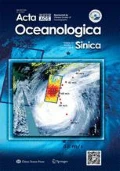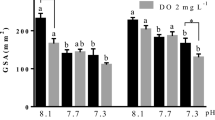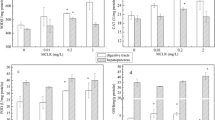Abstract
Marine zooplankton responds sensitively to elevated seawater CO2 concentration. However, the underlying physiological mechanisms have not been studied well. We therefore investigated the effects of elevated CO2 concentration (0.08%, 0.20%, 0.50% and 1.00%) on antioxidant defense components, as well as two detoxification enzymes of Calanus sinicus (copepod). The results showed that glutathione peroxidase (GPx) activity exposed to CO2-acidified seawater was significantly stimulated while other antioxidant components, including glutathione-S-transferase (GST) activity, superoxide dismutase (SOD) activity decreased significantly with reduced glutathione (GSH) level and GSH/oxidized glutathione (GSSG) value. CO2-acidified seawater exhibited stimulatory effects on adenosine triphosphatase (ATPase) activity and acetylcholinesterase (AchE) activity was inhibited. Moreover, the results of principal component analysis indicated that 75.93% of the overall variance was explained by the first two principal components. The elevated CO2 concentration may affect the metabolism and survivals of copepods through impacts these enzymes activities. Further studies are needed to focus on the synergistic effects of elevated CO2 concentration and other environmental factors on copepods.
Similar content being viewed by others
References
Bradford M M. 1976. A rapid and sensitive method for the quantitation of microgram quantities of protein utilizing the principle of protein-dye binding. Analytical Biochemistry, 72(1–2): 248–254
Byrne M, Soars N, Selvakumaraswamy P, et al. 2010. Sea urchin fertilization in a warm, acidified and high pCO2 ocean across a range of sperm densities. Marine Environmental Research, 69(4): 234–239
Caldeira K, Wickett M E. 2005. Ocean model predictions of chemistry changes from carbon dioxide emissions to the atmosphere and ocean. Journal of Geophysical Research: Oceans, 110(C9): C09S04
Caulfield J A, Adams E E, Auerbach D I, et al. 1997. Impacts of ocean CO2 disposal on marine life: ?. probabilistic plume exposure model used with a time-varying dose-response analysis. Environmental Modeling & Assessment, 2(4): 345–353
Christen R, Schackmann R W, Shapiro B M. 1983. Metabolism of sea urchin sperm. interrelationships between intracellular pH, ATPase activity, and mitochondrial respiration. Journal of Biological Chemistry, 258(9): 5392–5399
Delille B, Harlay J, Zondervan I, et al. 2005. Response of primary production and calcification to changes of pCO2 during experimental blooms of the coccolithophorid Emiliania huxleyi. Global Biogeochemistry Cycles, 19(2): GB2023
Doney S C, Fabry V J, Feely R A, et al. 2009. Ocean acidification: the other CO2 problem. Annual Review of Marine Science, 1(1): 169–192
Ellman G L, Courtney K D, Andres V Jr, et al. 1961. A new and rapid colorimetric determination of acetylcholinesterase activity. Biochemical Pharmacology, 7(2): 88–95, doi: 10.1016/0006- 2952(61)90145-9
Engel A, Zondervan I, Aerts K, et al. 2005. Testing the direct effect of CO2 concentration on a bloom of the coccolithophorid Emiliania huxleyi in mesocosm experiments. Limnology and Oceanography, 50(2): 493–507
Forget J, Beliaeff B, Bocquené G. 2003. Acetylcholinesterase activity in copepods (Tigriopus brevicornis) from the Vilaine River estuary, France, as a biomarker of neurotoxic contaminants. Aquatic Toxicology, 62(3): 195–204
Frova C. 2006. Glutathione transferases in the genomics era: new insights and perspectives. Biomolecular Engineering, 23(4): 149–169
Galgani F, Bocquene G. 1990. In vitro inhibition of acetylcholinesterase from four marine species by organophosphates and carbamates. Bulletin of Environmental Contamination and Toxicology, 45(2): 243–249
Habig W H, Pabst M J, Jakoby W B. 1974. Glutathione S-transferases: the first enzymatic step in mercapturic acid formation. Journal of Biological Chemistry, 249(22): 7130–7139
Hayes J D, Flanagan J U, Jowsey I R. 2005. Glutathione transferases. Annual Review of Pharmacology and Toxicology, 45: 51–88
Huesemann M H, Skillman A D, Crecelius E A. 2002. The inhibition of marine nitrification by ocean disposal of carbon dioxide. Marine Pollution Bulletin, 44(2): 142–148
Kurihara H, Ishimatsu A. 2008. Effects of high CO2 seawater on the copepod (Acartia tsuensis) through all life stages and subsequent generations. Marine Pollution Bulletin, 56(6): 1086–1090
Kurihara H, Shimode S, Shirayama Y. 2004a. Effects of raised CO2 concentration on the egg production rate and early development of two marine copepods (Acartia steueri and Acartia erythraea). Marine Pollution Bulletin, 49(9–10): 721–727
Kurihara H, Shimode S, Shirayama Y. 2004b. Sub-lethal effects of elevated concentration of CO2 on planktonic copepods and sea urchins. Journal of Oceanography, 60(4): 743–750
Lee Y M, Park T J, Jung S O, et al. 2006. Cloning and characterization of glutathione S-transferase gene in the intertidal copepod Tigriopus japonicus and its expression after exposure to endocrine-disrupting chemicals. Marine Environmental Research, 62(S1): S219–S223
Markovic D M, Žikic R V, Štajn A, et al. 2002. Some blood parameters and antioxidant defense enzyme activities in the liver of carps (Cyprinus carpio L.) under acute hypoxic conditions. Kragujevac Journal of Science, 24: 111–120
Mayor D J, Matthews C, Cook K, et al. 2007. CO2-induced acidification affects hatching success in Calanus finmarchicus. Marine Ecology Progress Series, 350: 91–97
Orr J C, Fabry V J, Aumont O, et al. 2005. Anthropogenic ocean acidification over the twenty-first century and its impact on calcifying organisms. Nature, 437(7059): 681–686
Pan C H, Chien Y H, Wang Yijuan. 2010. The antioxidant capacity response to hypoxia stress during transportation of characins (Hyphessobrycon callistus Boulenger) fed diets supplemented with carotenoids. Aquaculture Research, 41(7): 973–981
Pörtner H O. 2008. Ecosystem effects of ocean acidification in times of ocean warming: a physiologist’s view. Marine Ecology Progress Series, 373: 203–217
Pu Xinming, Sun Song, Yang Bo, et al. 2004. The combined effects of temperature and food supply on Calanus sinicus in the southern Yellow Sea in summer. Journal of Plankton Research, 26(9): 1049–1057
Pullman M E, Penefsky H S, Datta A, et al. 1960. Partial resolution of the enzymes catalyzing oxidative phosphorylation: I. Purification and properties of soluble dinitrophenol-stimulated adenosine triphosphatase. Journal of Biological Chemistry, 235: 3322–3329
Roberts D, Howard W R, Moy A D, et al. 2008. Interannual variability of pteropod shell weights in the high-CO2 southern ocean. Biogeosciences Discussions, 5(6): 4453–4480
Sabine C L, Feely R A, Gruber N, et al. 2004. The oceanic sink for anthropogenic CO2. Science, 305(5682): 367–371
Sampaio F G, De Lima Boijink C, Dos Santos L R B, et al. 2010. The combined effect of copper and low pH on antioxidant defenses and biochemical parameters in neotropical fish pacu, Piaractus mesopotamicus (Holmberg, 1887). Ecotoxicology, 19(5): 963–976
Seibel B A, Walsh P J. 2001. Potential impacts of CO2 injection on deep-sea biota. Science, 294(5541): 319–320
Shek L, Liu Hongbin. 2010. Oxygen consumption rates of fecal pellets produced by three coastal copepod species fed with a diatom Thalassiosira pseudonana. Marine Pollution Bulletin, 60(7): 1005–1009
Spitz D R Oberley L W. 1989. An assay for superoxide dismutase activity in mammalian tissue homogenates. Analytical Biochemistry, 179(1): 8–18
Stumpp M, Dupont S, Thorndyke M C, et al. 2011a. CO2 induced seawater acidification impacts sea urchin larval development: gene expression patterns in pluteus larvae. Comparative Biochemistry and Physiology Part A: Molecular & Integrative Physiology, 160(3): 320–330
Stumpp M, Wren J, Melzner F, et al. 2011b. CO2 induced seawater acidification impacts sea urchin larval development I: elevated metabolic rates decrease scope for growth and induce developmental delay. Comparative Biochemistry and Physiology Part A: Molecular & Integrative Physiology, 160(3): 331–340
Tanner C A, Burnett L E, Burnett K G. 2006. The effects of hypoxia and pH on phenoloxidase activity in the Atlantic blue crab, Callinectes sapidus. Comparative Biochemistry and Physiology Part A: Molecular & Integrative Physiology, 144(2): 218–223
Todgham A E, Hofmann G E. 2009. Transcriptomic response of sea urchin larvae Strongylocentrotus purpuratus to CO2-driven seawater acidification. Journal of Experimental Biology, 212(16): 2579–2594
Wall C B, Fan T Y, Edmunds P J. 2014. Ocean acidification has no effect on thermal bleaching in the coral Seriatopora caliendrum. Coral Reefs, 33(1): 119–130
Wang Minghua, Wang Guizhong. 2009. Biochemical response of the copepod Tigriopus japonicus Mori experimentally exposed to cadmium. Archives of Environmental Contamination and Toxicology, 57(4): 707–717
Wang Minghua, Wang Guizhong. 2010. Oxidative damage effects in the copepod Tigriopus japonicus Mori experimentally exposed to nickel. Ecotoxicology, 19(2): 273–284
Xia Yiming, Zhu Lianzhen. 1987. Measurement method of glutathione peroxidase activity in blood and tissue. Journal of Hygiene Research (in Chinese), 16(4): 29–33
Zhang Dajuan, Li Shaojing, Wang Guizhong, et al. 2011. Impacts of CO2-driven seawater acidification on survival, egg production rate and hatching success of four marine copepods. Acta Oceanologica Sinica, 30(6): 86–94
Zhang Dajuan, Li Shaojing, Wang Guizhong, et al. 2012. Biochemical responses of the copepod Centropages tenuiremis to CO2-driven acidified seawater. Water Science & Technology, 65(1): 30–37
Author information
Authors and Affiliations
Corresponding author
Rights and permissions
About this article
Cite this article
Zhang, D., Guo, D., Wang, G. et al. Response of antioxidant defense system in copepod Calanus sinicus Brodsky exposed to CO2-acidified seawater. Acta Oceanol. Sin. 35, 82–88 (2016). https://doi.org/10.1007/s13131-016-0870-5
Received:
Accepted:
Published:
Issue Date:
DOI: https://doi.org/10.1007/s13131-016-0870-5




